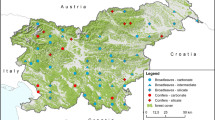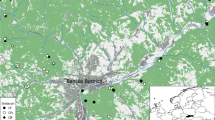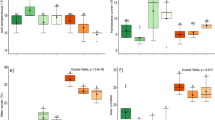Abstract
Forest pastures, like many other semi-natural (traditional) rural biotopes, have undergone a drastic decline both in area and quality during the last century in many areas. We explored the bryophyte flora of Finnish coniferous forest pastures on acidic soil and aimed to recognize the most important microsites (rocks, coarse woody debris, tree bases, mineral soil patches and closed vegetation) for bryophyte diversity. The effects of microhabitat heterogeneity (microsite entropy) on bryophytes was also examined. We found altogether 83 bryophyte species. The only red-listed species, Tayloria tenuis, was frequently found on dung patches and a few rare ruderal species grew exclusively on bare mineral soil. Rocks comprised the most species rich microsite and many common forest floor species showed preference for this microsite. Microhabitat heterogeneity explained bryophyte species richness on both alpha (plot average) and gamma (pasture total) scales. The results suggest that certain individual bryophyte species and their microsites should be taken into account in the management of this biotope, rather than guiding the management solely on the basis of the overall bryophyte diversity.


Similar content being viewed by others
References
Ahti T, Hämet-Ahti L, Jalas J (1968) Vegetation zones and their sections in northwestern Europe. Ann Bot Fenn 5:169–211
Berg A, Gärdenfors U, Hallingbäck T, Noren M (2002) Habitat preferences of red-listed fungi and bryophytes in woodland key habitats in southern Sweden - analyses of data from a national survey. Biodivers Conserv 11:1479–1503
Chiarucci A, Bacaro G, Rocchini D, Fattorini L (2008) Discovering and rediscovering the sample-based rarefaction formula in the ecological literature. Community Ecol 9:121–123
Chiarucci A, Bacaro G, Rocchini D, Ricotta C, Palmer MW, Scheiner SM (2009) Spatially constrained rarefaction: incorporating the autocorrelated structure of biological communities into sample-based rarefaction. Community Ecol 10:209–214
Cole HA, Newmaster SG, Bell FW, Pitt D, Stinson A (2008) Influence of microhabitat on bryophyte diversity in Ontario mixedwood boreal forest. Can J For Res 38:1867–1876
Dufrêne M, Legendre P (1997) Species assemblages and indicator species: the need for a flexible asymmetrical approach. Ecol Monogr 67:345–366
Dynesius M, Hylander K (2007) Resilience of bryophyte communities to clear-cutting of boreal stream-side forests. Biol Conserv 135:423–434
Dynesius M, Hylander K, Nilsson C (2009) High resilience of bryophyte assemblages in streamside compared to upland forests. Ecology 90:1042–1054
European commission (2009) Report from the Commission to the Council and the European Parliament. Composite Report on the Conservation Status of Habitat Types and Species as required under Article 17 of the Habitats Directive. KOM (2009) 358 final. Bryssel 13.7.2009
Gotelli NJ, Colwell RK (2001) Quantifying biodiversity: procedures and pitfalls in the measurement and comparison of species richness. Ecol Lett 4:379–391
Grönroos J, Hietala-Koivu R, Kuussaari M, Laitinen P, Lankoski J, Lemola R, Perälä P, Puustinen M, Schulman A, Salo T, Siimes K, Turtola E (2007) Analysis on the Finnish agri-environmental programme 2006-2007. Finnish Environ 19(2007):1–168 [In Finnish with English summary]
Hylander K (2005) Aspect modifies the magnitude of edge effects on bryophyte growth in boreal forests. J Appl Ecol 42:518–525
Hylander K, Johnson S (2010) In situ survival of forest bryophytes in small-scale refugia after an intense forest fire. J Veg Sci 21:1099–1109
Hylander K, Dynesius M, Jonsson BG, Nilsson C (2005) Substrate form determines the fate of bryophytes in riparian buffer strips. Ecol Appl 15:674–688
Jonsson BG, Esseen PA (1990) Treefall disturbance maintains high bryophyte diversity in a boreal spruce forest. J Ecol 78:924–936
Jonsson BG, Esseen PA (1998) Plant colonization in small forest-floor patches: importance of plant group and disturbance traits. Ecography 21:518–526
Laaka-Lindberg S, Anttila S, Syrjänen K (2009) Suomen uhanalaiset sammalet. Vammalan kirjapaino Oy, Sastamala, pp 1–344 [Threatened Bryophytes of Finland]
Madzule L, Brumelis G, Tjarve D (2012) Structures determining bryophyte species richness in a managed forest landscape in boreo-nemoral Europe. Biodivers Conserv 21:437–450
Marialigeti S, Nemeth B, Tinya F, Odor P (2009) The effects of stand structure on ground-floor bryophyte assemblages in temperate mixed forests. Biodivers Conserv 18:2223–2241
McCune B, Mefford MJ (1999) PC-ORD. Multivariate Analysis of Ecological Data, Version 5.0. MjM Software, Gleneden Beach, Oregon
Mills SE, Macdonald SE (2004) Predictors of moss and liverwort species diversity of microsites in conifer-dominated boreal forest. J Veg Sci 15:189–198
Odor P, Heilmann-Clausen J, Christensen M, Aude E, van Dort KW, Piltaver A, Siller I, Veerkamp MT, Walleyn R, Standovar T, van Hees AFM, Kosec J, Matocec N, Kraigher H, Grebenc T (2006) Diversity of dead wood inhabiting fungi and bryophytes in semi-natural beech forests in Europe. Biol Conserv 131:58–71
Poschold P, WallisDeVries MF (2002) The historical and socioeconomical perspective of calcareous grasslands—lessons from the distant and recent past. Biol Conserv 104:361–376
Rajandu E, Kikas K, Paal J (2009) Bryophytes and decaying wood in Hepatica site-type boreo-nemoral Pinus sylvestris forests in Southern Estonia. For Ecol Manag 257:994–1003
Rassi P, Hyvärinen E, Juslén A, Mannerkoski I (eds) (2010) Suomen lajien uhanalaisuus—Punainen kirja 2010 [The 2010 Red List of Finnish Species]. Ministry of the Environment and Finnish Environment Institute, Helsinki, pp 1–685
Renvall P (1995) Community structure and dynamics of wood rotting Basidiomycetes on decomposing conifer trunks in northern Finland. Karstenia 35:1–51
Ross-Davis AL, Frego KA (2002) Comparison of plantations and naturally regenerated clearcuts in the Acadian Forest: forest floor bryophyte community and habitat features. Can J Botany 80:21–33
Schmalholz M, Hylander K (2011) Rocks increase resistance to clear-cut logging but not subsequent recolonization rates of boreal bryophytes. Oecologia 167:1093–1101
Schulman A, Alanen A, Haeggström C-A, Huhta A-P, Jantunen J, Kekäläinen H, Lehtomaa L, Pykälä J, Vainio M (2008) Perinnebiotoopit [Traditional rural biotopes]. Suomen ympäristö [The Finnish Environment] 8(2008):399–465
Shannon CE (1948) A mathematical theory of communication. Bell Syst Tech J 27:623–656
Shelley AE, Halpern CB, McKenzie D (2012) The contributions of forest structure and substrate to bryophyte diversity and abundance in mature coniferous forests of the Pacific Northwest. Bryologist 115:278–294
Söderström L (1988) The occurrence of epixylic bryophyte and lichen species in an old natural and a managed forest stand in northeast Sweden. Biol Conserv 45:169–178
Takala T, Tahvanainen T, Kouki J (2012) Can re-establishment of cattle grazing restore bryophyte diversity in abandoned mesic semi-natural grasslands? Biodivers Conserv 21:981–992
Takala T, Tahvanainen T, Kouki J (2014) Grazing promotes bryophyte species richness in semi-natural grasslands. Ann Bot Fenn 51:148–160
Ulvinen T, Syrjänen K, Anttila S, (2002) Suomen sammalet: levinneisyys, ekologia, uhanalaisuus [Bryophytes of Finland: distribution, ecology and red list status]. Finnish Environ 560:180–312 In Finnish with English summary
Ulvinen T, Syrjänen K, Juutinen R (2013) Suomen sammalien levinneisyys eliömaakunnissa 4. [Distribution of the Finnish bryophytes in the biogeographical provinces]. Finnish Environment Institute 1.3.2013 (http://www.ymparisto.fi/download.asp?contentid=142293&lan=fi)
Vainio M, Kekäläinen H, Alanen A, Pykälä J (2001) Traditional rural biotopes in Finland. Final report of the nationwide inventory. Finnish Environ 527:1–163 [In Finnish with English summary]
Vellak K, Paal J (1999) Diversity of bryophyte vegetation in some forest types in Estonia: a comparison of old unmanaged and managed forests. Biodivers Conserv 8:1595–1620
Weibull H, Rydin H (2005) Bryophyte species richness on rocks: relationship to area, habitat diversity and canopy tree species. Biol Conserv 122:71–79
Acknowledgments
We thank the Jenny and Antti Wihuri foundation for financial support to this study.
Author information
Authors and Affiliations
Corresponding author
Additional information
Communicated by T.G. Allan Green.
Rights and permissions
About this article
Cite this article
Takala, T., Kouki, J. & Tahvanainen, T. Bryophytes and their microhabitats in coniferous forest pastures: should they be considered in the pasture management?. Biodivers Conserv 23, 3127–3142 (2014). https://doi.org/10.1007/s10531-014-0769-4
Received:
Revised:
Accepted:
Published:
Issue Date:
DOI: https://doi.org/10.1007/s10531-014-0769-4




